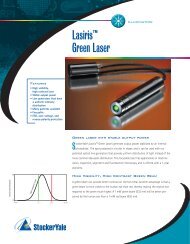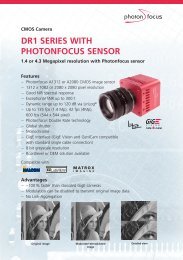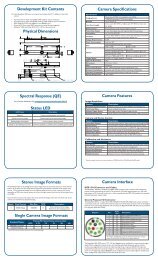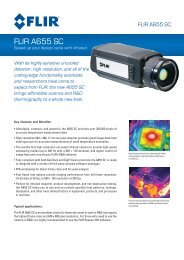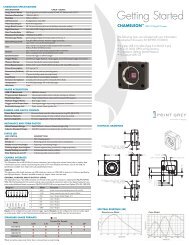You also want an ePaper? Increase the reach of your titles
YUMPU automatically turns print PDFs into web optimized ePapers that Google loves.
Point Grey <strong>Blackfly</strong> Technical Reference<br />
8 <strong>Blackfly</strong> Attributes<br />
8.8 Brightness<br />
Brightness, also known as offset or black level, controls the level of black in an image.<br />
The camera supports brightness control.<br />
Access this feature using:<br />
GenICam<br />
Analog Control<br />
8.9 Exposure<br />
FlyCapture<br />
Example: Setting Brightness Using the FlyCapture API<br />
The <strong>Blackfly</strong> supports continuous, once, and manual (off) control of the image sensor exposure time. Exposure times<br />
are scaled by the divider of the basic frame rate. For example, dividing the frame rate by two (e.g. 15 FPS to 7.5 FPS)<br />
causes the maximum exposure time to double (e.g. 66 ms to 133 ms).<br />
The supported exposure time range is 0.015 ms to 1 second (extended shutter mode).<br />
The terms “integration”, “exposure” and "shutter" are interchangeable.<br />
For CMOS cameras, continuous and once control is only supported in freerunning<br />
mode.<br />
The time between the end of exposure for consecutive frames is always constant. However, if the exposure time is<br />
continually changing (e.g. being controlled by Auto Exposure), the time between the beginning of consecutive<br />
integrations will change. If the exposure time is constant, the time between integrations will also be constant.<br />
The camera continually exposes and reads image data off of the sensor under the following conditions:<br />
1. The camera is powered up; and<br />
2. The camera is in free running, not asynchronous trigger, mode. When in trigger mode, the camera simply<br />
clears the sensor and does not read the data off the sensor.<br />
The camera continues to expose images even when data transfer is disabled and images are not being streamed to<br />
the computer. The camera continues exposing images in order to keep things such as the auto exposure algorithm (if<br />
enabled) running. This ensures that when a user starts requesting images, the first image received is properly<br />
exposed.<br />
When operating in free-running mode, changes to the exposure value take effect with the next captured image, or<br />
the one after next. Changes to exposure in asynchronous trigger mode generally take effect on the next trigger.<br />
Revised 12/13/2012<br />
Copyright ©2012 Point Grey Research Inc.<br />
51



